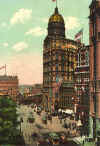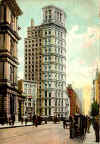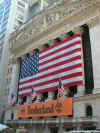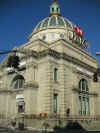|
New York Architecture Images-New York Architects George B. Post |
||||
| New York works; | ||||

|

|
 |

|
 |
| 007 THE NEW YORK WORLD BUILDING | 012 The St. Paul Building | 016 Western Union Telegraph Building | 036 NEW YORK STOCK EXCHANGE | 020- Williamsburgh Savings Bank |
|
During his prolific career,
George B. Post (1837 - 1913) demonstrated innovative engineering skill,
which facilitated his creation of large, open interior spaces as well as
his pioneering work in the construction of skyscrapers. His Equitable
Life Assurance Society building was the first office building to use
elevators. In addition, his World Building and St. Paul building had the
distinction of being the tallest buildings in New York at the time of
their construction. One of his commercial masterpieces, the vast New
York Produce Exchange, had an enormous sky-lighted hall. All of these
buildings have been demolished. The New York Stock Exchange survives as
an example of his creation of uncluttered interior spaces through
inventive use of steel supports.
|
||||
|
links |
||||